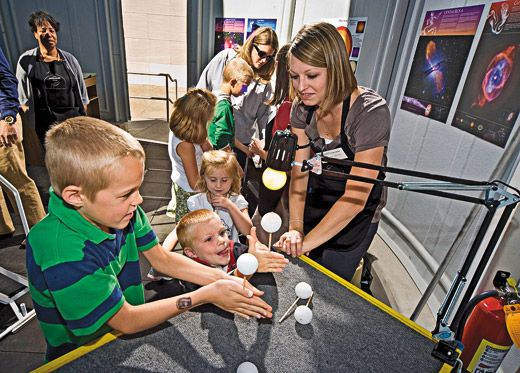Up with Science
/https://tf-cmsv2-smithsonianmag-media.s3.amazonaws.com/filer/From-The-Castle-Smithsonian-Solar-System-Tutorial-631.jpg)
Atlanta's huge Hartsfield-Jackson airport is one of the world's busiest; each year 82 million passengers go through it. And it is but one of more than 1,000 sites worldwide—such as public parks, metro stations, arts festivals, libraries and hospitals—where people can see spectacular astronomical images provided by the award-winning From Earth to the Universe, a project of the Chandra group at the Smithsonian Astrophysical Observatory.
Especially after World War II, America's leaders came to understand the importance of science and technology. The National Science Foundation, founded in 1950, offered increased funding to universities and nonprofit organizations. Sputnik's 1957 launch further stimulated research investment. By 1958, total federal funding for scientific research and development was $7 billion. The U.S. government now spends more than $100 billion on R&D; the private sector invests another $290 billion or so. Science and technology underpin our country's success in global competition. The Internet, space exploration and other key advances were spawned by past investments in science.
Yet our country faces many critical decisions. How do we handle climate change and other environmental challenges? How much should we invest in alternative fuels? How will we repair our decaying infrastructure? Finding answers will require in-depth public understanding of science and technology. But polls suggest that scientific literacy is on the wane, and science education is declining. Our K-12 mathematics and science education ranks 48th worldwide, while 49 percent of U.S. adults don't know how long it takes for Earth to circle the Sun (a year). Science and engineering are devolving into ever-smaller specialties, and few scientists and engineers effectively communicate the broader contexts of key issues.
To increase scientific literacy, partnerships of government agencies like NSF and NASA with universities, science museums, corporations and science and engineering associations are essential. New strategic search tools will also be needed to explore general information—not just the specialized knowledge that only a few understand—about science and technology. The Smithsonian Natural History Museum's Ocean Portal and Human Origins Web sites are good examples of such tools.
The Smithsonian must play a central role in a coordinated national effort to foster scientific literacy, and involve all of our K-12 science programs, including those in our various museums, research centers and the National Zoo. By promoting scientific literacy and convening key partners to address the critical issues of our time, we will enhance 21st-century relevance for the Smithsonian's enduring mission—the increase and diffusion of knowledge.
G. Wayne Clough is Secretary of the Smithsonian Institution.
/https://tf-cmsv2-smithsonianmag-media.s3.amazonaws.com/accounts/headshot/wayne-clough-240.png)

/https://tf-cmsv2-smithsonianmag-media.s3.amazonaws.com/accounts/headshot/wayne-clough-240.png)